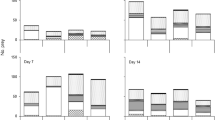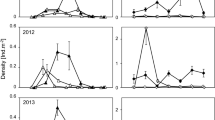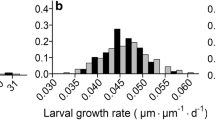Abstract
A fundamental feature of fish and many other taxa is their potential for individuals to grow during most of their life. While increasing in size, fish undergo size-specific changes in niche, generally involving an increase in the mean size of prey eaten. Considering foraging efficiency alone, these ontogenetic niche shifts can be related to morphological changes and increasing energetic costs. The former is a result of an increased capacity to capture larger prey and a loss in the ability to capture and retain smaller prey, while the latter relates to the necessity to switch to increasingly larger prey to compensate for increased energetic demands with increasing body size (Kerr 1971; Mittelbach 1981; Persson 1987 a). Since individual growth rates in fish are indeterminant and dependent on resource supply, resource competition will directly affect ontogenetic niche shifts by depressing growth rates. In most cases, however, competition and predation interact and ontogenetic niche shifts in fishes are therefore often a result of both competitive and predatory processes (Gilliam 1982; Werner and Gilliam 1984; Werner 1986; Mittelbach and Chesson 1987; Gilliam and Fraser this Vol.). An illustrative example of how competitive interactions interact with predation is competition-induced reduction in growth rate, which will prolong the time the fish is susceptible to gap-limited predators (Tonn et al. 1986). The strength of competitive and predatory interactions respectively may also change ontogenetically such that while competitive interactions are prevailing between certain size (age) classes, predatory interactions are prevailing between others.
Access this chapter
Tax calculation will be finalised at checkout
Purchases are for personal use only
Preview
Unable to display preview. Download preview PDF.
Similar content being viewed by others
References
Alm G (1946) Reasons fo the occurrence of stunted fish populations with special reference to perch. Rep Inst Freshwater Res Drottningholm 25.
Alm G (1952) Year class fluctuations and span of life of perch. Rep Inst Freshwater Res Drottningholm 33:17–38.
Alm G (1959) Connection between maturity, size and age in fishes. Rep Inst Freshwater Res Drottningholm 40:5–145.
Andersson G (1984) The role of fish in lake ecosystems — and in limnology. In: Bosheim S, Nicholls M (eds) Interaksjoner mellan trofiske nivåer i ferskvann, Nordisk limnologisymposium, Oslo, 1984, pp 189-197.
Craig JF (1978) A study of the food and feeding of perch, Perca fluviatilis L. in Windermere. Freshwater Biol 8:59–68.
Diehl S (1988) Foraging efficiency of three freshwater fish: Effects of structural complexity and light. Oikos 53:207–214.
Filipsson O, Svärdson G (1976) Principer för fiskevården i rödingsjöar. Inform Inst Freshwat Res Drottningholm 2 (Mimeographed in Swedish with English summary).
Fish GR (1960) The comparative activity of some digestive enzymes in the alimentary canal of Tilapia and Perch. Hydrobiology 15:161–178.
Fretwell SD (1977) The regulation of plant communities by the food chains exploiting them. Perspect Biol Med 20:169–185.
Gilliam JF (1982) Habitat use and competitive bottlenecks in size-structured fish populations. Thesis, Michigan State Univ, East Lansing.
Gilliam JF, Fraser DF (1987) Habitat selection when foraging under predation hazard: A model and a test with stream-dwelling minnows. Ecology 68:1856–1862.
Gumaá SA (1978) The food and feeding habits of young perch, Perca fluviatilis, in Windermere. Freshwater Biol 8:177–187.
Hansson L-A, Johansson L, Persson L (1987) Effects of fish grazing on nutrient release and succession of primary producers. Limnol Oceanogr 32:723–729.
Hofer WMR, Wieser W (1987) Diet spectra and resource partitioning in the larvae and juveniles of three species and six cohorts of cyprinids from a subalpine lake. Oecologia (Berlin) 71:388–396.
Johannes RD, Larkin PA (1961) Competition for food between redside shiners and rainbow trout in two British Columbia lakes. J Fish Res Board Can 18:203–220.
Johansson L (1987) Experimental evidence for interactive habitat segregation between roach (Rutilus rutilus) and rudd (Scardinius erythrophthalmus). Oecologia (Berlin) 73:21–27.
Johansson L, Persson L (1986) The fish community of temperate, eutrophic lakes. In: Riemann B, Sondergaard M (eds) Carbon dynamics of eutrophic, temperate lakes: The structure and functions of the pelagic environment. Elsevier, Amsterdam, pp 237–266.
Kapoor BG, Smit H, Verighina IA (1975) The alimentary canal and digestion in teleosts. In: Russell F, Younge M (eds) Advances in marine biology, vol 13. Academic Press, New York London, pp 109–239.
Kerr SR (1971) Analysis of laboratory experiments on growth efficiency of fishes. J Fish Res Board Can 28:801–808.
Larkin PA (1956) Interspecific competition and population control in freshwater fish. J Fish Res Board Can 13:327–340.
Larkin PA, Smith SB (1954) Some effects of introduction of the redside shiner on the Kamloops trout in Paul Lake, British Columbia. Trans Am Fish Soc 83:161–175.
Lessmark O (1983) Competition between perch (Perca fluviatilis) and roach (Rutilus rutilus) in South Swedish lakes. Thesis, Univ Lund.
Levins R (1979) Asymmetric competition among distant taxa. Am Zool 19:1097–1104.
Miller TE, Kerfoot WC (1987) Redefining indirect effects. In: Kerfoot WC, Sih A (eds) Predation: direct and indirect impacts on aquatic communities. Univ Press New Engl, Hanover London, pp 33–37.
Mittelbach GG (1981) Foraging efficiency and body size: a study of optimal diet and habitat use by bluegills. Ecology 62:1370–1386.
Mittelbach GG (1983) Optimal foraging and growth in bluegills. Oecologia (Berlin) 59:157–162.
Mittelbach GG, Chesson PL (1987) Predation risk: Indirect effects on fish populations. In: Kerfoot WC, Sih A (eds) Predation: direct and indirect impacts on aquatic communities. Univ Press New Engl, Hanover London, pp 315–332.
Neill WE (1975) Experimental studies of microcrustacean competition, community composition and resource utilization. Ecology 56:809–826.
Neill WE (1981) Impact of Chaborous predation on the structure and dynamics of crustacean Zooplankton community. Oecologia (Berlin) 48:164–177.
Neill WE, Peacock A (1980) Breaking the bottleneck: Interactions of invertebrate predators and nutrients in oligotrophic lakes. In: Kerfoot WC (ed) Evolution and ecology of Zooplankton communities. Univ Press New Engl, Hanover, NH, pp 715–724.
Nilsson N-A (1960) Seasonal fluctuations in the food segregation of trout, char and white fish in 14 North-Swedish lakes. Rep Inst Freshwater Res Drottningholm 41:185–205.
Nilsson N-A (1965) Food segregation between salmonid species in North Sweden. Rep Inst Freshwater Res Drottningholm 46:58–73.
Nilsson N-A (1965) Interactive segregation between fish species. In: Gerking SD (ed) The biological basis of freshwater fish production. Blackwell, Oxford, pp 296–313.
Nyberg P (1976) Production and food consumption of perch in two Swedish forest lakes. Thesis, Univ Uppsala.
Nyberg P (1979) Production and food consumption of perch, Perca fluviatilis L., in two Swedish forest lakes. Rep Inst Freshwater Res Drottningholm 58:140–157.
Oksanen L, Fretwell SD, Arruda J, Niemelä P (1981) Exploitation ecosystems in gradients of primary productivity. Am Nat 118:240–261.
Persson L (1983a) Food consumption and competition between age classes in a perch Perca fluviatilis population in a shallow eutrophic lake. Oikos 40:197–207.
Persson L (1983b) Food consumption and the significance of detritus and algae to intraspecific competition in roach Rutilus rutilus in a shallow eutrophic lake. Oikos 41:118–125.
Persson L (1983c) Effects on intra-and interspecific competition on dynamics and size structure of a perch Perca fluviatilis and a roach Rutilus rutilus population. Oikos 41:126–132.
Persson L (1985) Asymmetrical competition: Are larger animals competitively superior? Am Nat 126:261–266.
Persson L (1986) Effects of reduced interspecific competition on resource utilization in perch (Perca fluviatilis). Ecology 67:355–364.
Persson L (1987a) The effects of resource availability and distribution on size class interactions in perch Perca fluviatilis. Oikos 48:148–160.
Persson L (1987b) Competition-induced diet shift in young-of-the-year perch (Perca fluviatilis): An experimental test of resource limitation. Environ Biol Fish 19:235–239.
Persson L (1987c) Effects of habitat and season on competitive interactions between roach (Rutilus rutilus) and perch (Perca fluviatilis). Oecologia (Berlin) 73:170–177.
Persson L, Greenberg LA (1989) Competitive juvenile bottlenecks: The perch (Perca fluviatilis)-roach (Rutilus rutilus) interaction. Ecology (in press).
Persson L, Andersson G, Hamrin SF, Johansson L (1988) Predator regulation and primary productivity along the productivity gradient of temperate lake ecosystems. In: Carpenter SC (ed) Complex interactions in lake communities. Springer Verlag, New York Berlin Heidelberg.
Popova OA, Sytina LA (1977) Food and feeding relations of Eurasian perch (Perca fluviatilis) and pikeperch (Stizostedion lucioperca) in various waters of the USSR. J Fish Res Board Can 34:1559–1570.
Prejs A (1984) Herbivory by temperate freshwater fishes and its consequences. Environ Biol Fish 10:281–296.
Rieman B, Søndergaard M, Persson L, Johansson L (1986) Carbon metabolism and community regulation in eutrophic, temperate lakes. In: Riemann B, Søndergaard M (eds) Carbon dynamics of eutrophic, temperate lakes: the structure and functions of the pelagic environment. Elsevier, Amsterdam, pp 267–280.
Sand-Jensen K (1979) Balancen mellan autotrofe komponenter i tempererade søer med forskellig nœringsbelastning. Vatten 2/80:104–115 (In Danish with English summary).
Schoener TW (1982) The controversy over interspecific competition. Am Sci 70:586–595.
Sorokin JI (1968) The use of 14C in the study of nutrition of aquatic animals. Mitt Int Verein Theor Angew Limnol 16.
Sumari O (1971) Structure of perch populations in some ponds in Finland. Ann Zool Fennici 8:406–421.
Svärdson G (1976) Interspecific population dominance in fish communities. Rep Inst Freshwater Inst Drottningholm 56:144–171.
Thorpe JE (1977) Daily ration of adult perch, Perca fluviatilis L., in Loch Leven, Scotland. J Fish Biol 11:55–68.
Tonn WM, Paszkowski CA, Moermond TC (1986) Competition in Umbra-Perca fish assemblages: experimental and field evidence. Oecologia (Berlin) 69:126–133.
Werner EE (1977) Species packing and niche complementarity in three sunfishes. Am Nat 11:553–578.
Werner EE (1986) Species interactions in freshwater fish communities. In: Diamond J, Case T (eds) Community ecology. Harper & Row, New York, pp 344–358.
Werner EE, Hall DJ (1979) Foraging efficiency and habitat switching in competing sunfishes. Ecology 60:256–264.
Werner EE, Gilliam JF (1984) The ontogenetic niche and species interactions in size-structured populations. Annu Rev Ecol Syst 15:393–425.
Wetzel RG (1979) The role of the littoral zone and detritus in lake metabolism. Arch Hydrobiol Beih Ergebn Limnol 13:145–161.
Willemsen J (1977) Population dynamics of percids in Lake Ijssel and some smaller lakes in the Netherlands. J Fish Res Board Can 34:1710–1719.
Author information
Authors and Affiliations
Editor information
Editors and Affiliations
Rights and permissions
Copyright information
© 1988 Springer-Verlag Berlin Heidelberg
About this paper
Cite this paper
Persson, L. (1988). Asymmetries in Competitive and Predatory Interactions in Fish Populations. In: Ebenman, B., Persson, L. (eds) Size-Structured Populations. Springer, Berlin, Heidelberg. https://doi.org/10.1007/978-3-642-74001-5_14
Download citation
DOI: https://doi.org/10.1007/978-3-642-74001-5_14
Publisher Name: Springer, Berlin, Heidelberg
Print ISBN: 978-3-642-74003-9
Online ISBN: 978-3-642-74001-5
eBook Packages: Springer Book Archive




